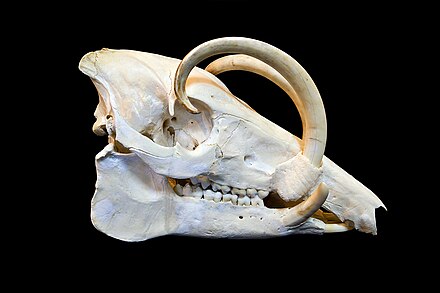Babirusa
The babirusas, also called deer-pigs (Indonesian: babi rusa[1]), are a genus, Babyrousa, in the swine family found in the Indonesian islands of Sulawesi, Togian, Sula and Buru.[2] All members of this genus were considered part of a single species until 2002, the babirusa, B. babyrussa, but following that was split into several species. This scientific name is restricted to the Buru babirusa from Buru and Sula, whereas the best-known species, the north Sulawesi babirusa, is named B. celebensis.[3] The remarkable "prehistoric" appearance of these mammals is largely due to the prominent upwards incurving canine tusks of the males, which actually pierce the flesh in the snout.[4]
All species of babirusa are listed as threatened by the International Union for Conservation of Nature (IUCN).[5]
The genus is monotypic within the subfamily Babyrousinae, or alternatively considered to form a tribe, Babyrousini, of the subfamily Suinae. To date, only one fossil skull has been found to suggest a larger ancestor.[6]
All members of the genus were considered part of a single species, the babirusa or pig-deer, B. babyrussa. They were split into several species, this scientific name is restricted to the Buru babirusa from Buru and the Sula Islands, whereas the best-known species, the north Sulawesi babirusa, is named B. celebensis.[3] The split, which uses the phylogenetic species concept, is based on differences in size, amount of hair on body and tail-tuft, and measurements of the skull and teeth.[3]
B. babyrussa beruensis was described as an extinct, Pleistocene subspecies from southwestern Sulawesi before babirusas were split into multiple species.
Babirusa are notable for the long upper canines in the males. The upper canines of male babirusa emerge vertically from the alveolar process, penetrating through the skin and curving backward over the front of the face and towards the forehead.[7][8] The lower canines also grow upwards. The canines of the female are either reduced or absent.[7] The structure of the male's canines vary by species. In the golden babirusa, the upper canines are short and slender with the alveolar rotated forward to allow the lower canines to cross the lateral view.[7] The Togian babirusa also has the same characteristics and the upper canines always converge. The North Sulawesi babirusa has long and thick upper canines with a vertically implanted alveolar. This caused the upper canines to emerge vertically and not cross with the lower canines.[9] Babirusa also vary by species in other characteristics. The golden babirusa has a long, thick pelage that is white, creamy gold, black or gold overall and black at the rump.[7] The pelage of the Togian babirusa is also long but not as that of the golden babirusa. The Togian babirusa has a tawny, brown or black pelage that is darker on the upper parts than in the lower parts.[7] The North Sulawesi babirusa has very short hair and appears bald. The female babirusa has only one pair of teats.[10]


